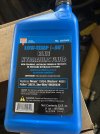- Joined
- Sep 26, 2009
- Messages
- 415
- Reaction score
- 132
- Points
- 43
- Location
- Massachusetts
- Model
- Express 330
There is a sea star hydraulic system on my 330 Express. Last year the steering wheel felt jumpy/sticky as it turned. Spent a while bleeding the system per Sea Star's web site. Pretty confident in that process, as I'd previously done it with a prior boat. The symptom returned after a couple trips. I need to sort this out. It is obvious there is a leak, or air is getting in, as the level at the helm is low.
I've not noticed any fluid leaks at the transom on either motor bracket. There is no visible leak at the helm. My next steps are to access behind and under the helm to ascertain if there is a visible leak there. From looking at the diagrams on the Sea Star site, it appears there may be splits in the line somewhere between the helm and transom to access both motors. Any idea where this might be located on the 330, I'm going on the theory that the most likely spot for leaks are at those joints, or the connections under the helm, either to the wheel, or to the autopilot bit.
Anything else I should look at? Also, is there any more involved process for bleeding when an autopilot is involved?
I've not noticed any fluid leaks at the transom on either motor bracket. There is no visible leak at the helm. My next steps are to access behind and under the helm to ascertain if there is a visible leak there. From looking at the diagrams on the Sea Star site, it appears there may be splits in the line somewhere between the helm and transom to access both motors. Any idea where this might be located on the 330, I'm going on the theory that the most likely spot for leaks are at those joints, or the connections under the helm, either to the wheel, or to the autopilot bit.
Anything else I should look at? Also, is there any more involved process for bleeding when an autopilot is involved?


